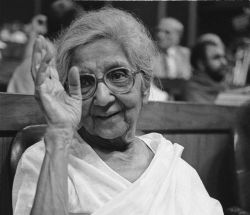Aruna Asaf Ali
Aruna Asaf Ali (16 July 1909, 29 July 1996) was a prominent Indian freedom fighter, educator, and political activist. She is remembered for her brave role in the Quit India Movement of 1942. She gained national attention when she hoisted the Indian National Congress flag at the Gowalia Tank Maidan in Bombay, now known as Mumbai, when many top leaders had been arrested.
| Aruna Asaf Ali | |
|---|---|

| |
| Aruna Asaf Ali in 1946 | |
| Born | 16 July 1909 |
| Birthplace | Kalka, Punjab Province, British India |
| Died | 29 July 1996 (aged 87) |
| Place of death | New Delhi, India |
| Resting place | Lodhi Garden, New Delhi |
| Nationality | Indian |
| Occupation | Freedom Fighter, Politician, Activist |
| Years active | 1930–1996 |
| Known for | Leading the Quit India Movement, Socialist and Leftist activism |
| Notable works | 1942 Flag Hoisting, Underground Freedom Movement, Inquilab publication |
| Awards | Bharat Ratna (posthumous, 1997), International Lenin Peace Prize (1964), Padma Vibhushan (1992) |
| Spouse(s) | Asaf Ali |
| Children | None |
| Parents | Upendranath Ganguly (father) |
| Religion | Hinduism |
| Website | Government Tribute Portal |
Known as the “Grand Old Lady of the Independence Movement” she was vital in underground resistance efforts, edited nationalist publications, and inspired young revolutionaries with her fearless spirit.[1][2]
After independence, Aruna Asaf Ali remained active in politics, education, and social reform. She served as Delhi’s first Mayor in 1958. In 1997, she was awarded India’s highest civilian honor, the Bharat Ratna, recognizing her lifelong contributions to the nation.
Early Life
Aruna Asaf Ali was born Aruna Ganguly on 16 July 1909 in Kalka, Punjab, which is now in Haryana. She received her early education at Sacred Heart Convent in Lahore and later studied at All Saints’ College in Nainital. Growing up in a liberal family, she was exposed to modern education and reformist ideas from a young age.
Despite the conservative norms of her time, Aruna adopted a progressive outlook and showed interest in social and political issues. Her marriage in 1928 to Asaf Ali, a well-known Congress leader and lawyer, marked a pivotal moment in her life. This union was unconventional as it crossed religious and social boundaries, reflecting her independent spirit and refusal to accept societal restrictions.[3]
Role in Freedom Movement
Aruna Asaf Ali’s courage during critical moments of India’s struggle for independence earned her lasting respect and a heroic legacy. She took part in the Salt Satyagraha of 1930, where she was arrested and labeled a vagrant. She refused to be released even after the Gandhi–Irwin Pact until public and political pressure got her freedom. While in Tihar Jail in 1932, she went on a hunger strike to protest the poor treatment of political prisoners, which led to real improvements in their conditions.
Her most famous moment came on 9 August 1942, when she boldly raised the Indian National Congress flag at Gowalia Tank Maidan (now August Kranti Maidan) in Bombay, right after the start of the Quit India Movement. With many Congress leaders already arrested, her action ignited widespread resistance and represented the movement’s strength. She continued her activism in secret, helping to organize resistance networks, handing out leaflets, and collaborating with nationalist leaders like Jayaprakash Narayan and Ram Manohar Lohia—all while avoiding arrest.[4][5][6][7][8]
Political Career
After independence, she associated with the Congress Socialist Party and later aligned with the Communist Party of India. She also co-founded the Link Publishing House, which published the *Patriot* newspaper.
Awards and Recognition
- Bharat Ratna (1997) – India’s highest civilian award (posthumously)
- Padma Vibhushan (1992)
- Lenin Peace Prize (1964) from the Soviet Union
- Honoured with postage stamps, institutions, and road names
Legacy
- Remembered as the “Grand Old Lady of Indian Independence”
- One of the first women to go underground for revolutionary activity
- Her life continues to inspire generations of women leaders and freedom lovers
See Also
- Quit India Movement
- Asaf Ali
- Congress Socialist Party
- Indian National Congress
- Indian Independence Movement
References
- ↑ Aruna Asaf Ali . In Encyclopedia Britannica . Retrieved 26 August 2025
- ↑ Aruna Asaf Ali was Delhi's first mayor . In The Economic Times . Retrieved 26 August 2025
- ↑ Biography of Aruna Asaf Ali . In India Net Zone . Retrieved 26 August 2025
- ↑ Azadi Ka Amrit Mahotsav: Remembering Aruna Asaf Ali, the Grand Old Lady of India’s Freedom Struggle . In OneIndia . Retrieved 28 August 2025
- ↑ Remembering Aruna Asaf Ali, the Indian freedom fighter who was so ahead of her times . In India Today (16 July 2018) . Retrieved 28 August 2025
- ↑ Aruna Asaf Ali . In Britannica . Retrieved 28 August 2025
- ↑ Independence Day 2024: Lesser-known female freedom fighters you should know about . In Republic World (15 August 2024) . Retrieved 28 August 2025
- ↑ Let’s Remember Forgotten Women Freedom Fighters . In SheThePeople . Retrieved 28 August 2025
